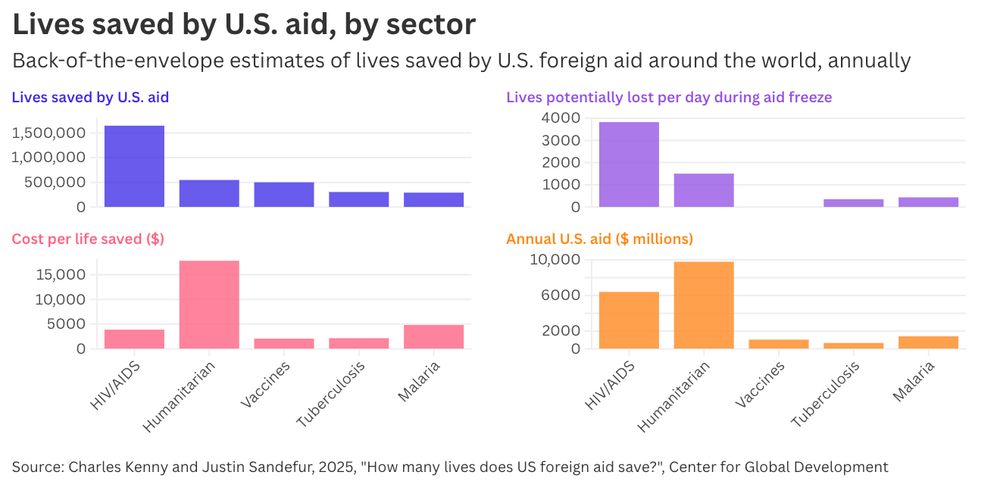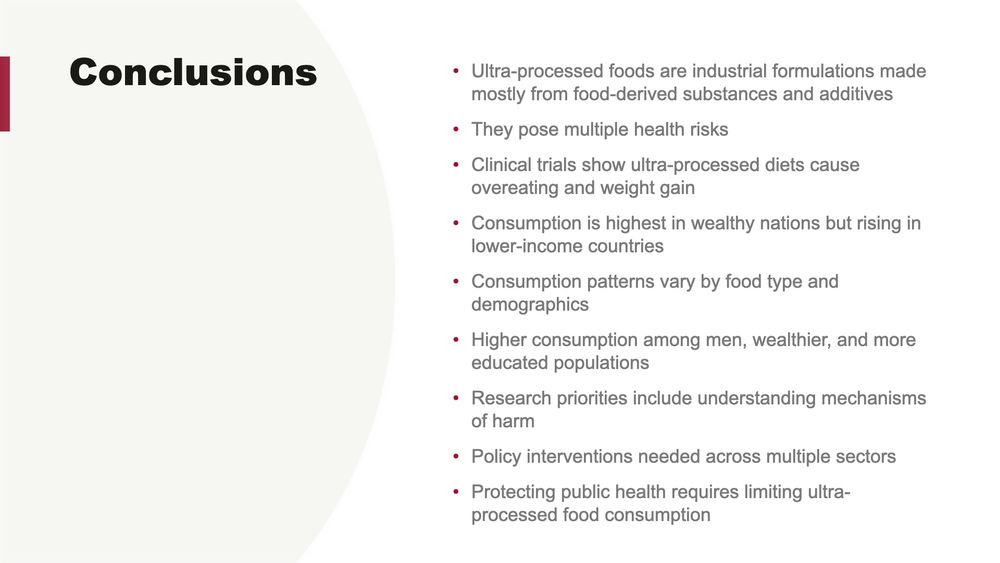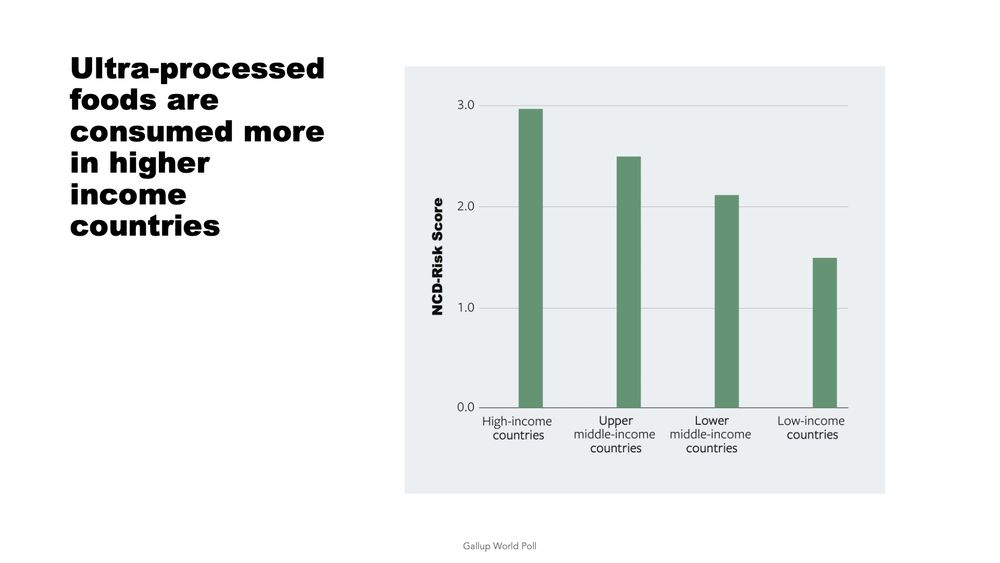
Great talk. Important contribution from Marit Kolby on the damage done by ultra-processed food products but also revealing how easy it can be to transition back to real food. @tybeal.bsky.social
podcasts.apple.com/us/podcast/u...
@tybeal.bsky.social

Great talk. Important contribution from Marit Kolby on the damage done by ultra-processed food products but also revealing how easy it can be to transition back to real food. @tybeal.bsky.social
podcasts.apple.com/us/podcast/u...

🍩 From donuts to global health: I presented at EFFoST on how ultra-processed foods are reshaping our food systems. Here's what you need to know about UPFs and their worldwide impact... 🧵
What's your favorite (and maybe not-so-healthy) UPF? 🤔

In a new analysis (note, back-of-the-envelope) @charlesjkenny.bsky.social and @justsand.bsky.social estimate that US foreign aid saves around 3.3 million lives per year.
You can read more about their methodology and results here:
www.cgdev.org/blog/how-man...

Musk Said No One Has Died Since Aid Was Cut. That Isn’t True. www.nytimes.com/interactive/...
15.03.2025 13:34 — 👍 2 🔁 4 💬 0 📌 0
Now that the Minimum Dietary Diversity (MDD) indicator has been adopted by the UN to address hunger and malnutrition, it's time to plan for how to collect this data. The good news is that we have developed a simple tool to do this worldwide.
www.gainhealth.org/media/news/u...

To say that the abrupt dismantling of USAID has devastated the global health and nutrition space is not an understatement. Must read piece in AJCNutrition on the loss of life and livelihoods. @christinestewart.bsky.social
ajcn.nutrition.org/article/S000...
Start here for the full thread on the global impact of ultra-processed foods and how to tackle the health crisis. 👇
bsky.app/profile/tybe...

Ultra-processed diets fuel obesity & NCDs. Intakes surging in poorer contexts. We need food systems to protect us from UPF harms.
🚫 Restrict marketing to kids
💰 Tax sodas, subsidize whole foods
🍽️ Reinvent menus in schools, institutions
🔬 Prioritize research on UPF mechanisms

Policy actions to reduce ultra-processed foods:
🚫 Taxes & subsidies to shift consumption (eg, soda)
🚫 Restrict marketing of ultra-processed to kids
🛒 Limits in schools & public institutions
🥕 Support food systems increasing access to affordable minimally processed

🔍🍔 Research priorities:
Identify mechanisms linking ultra-processed foods to poor health
Evaluate policies to reduce ultra-processing
Explore alternatives that maintain convenience & accessibility 🍎

📈 Clear pattern: UPF consumption follows wealth. High-income countries consume much more than low-income ones.
A glimpse of what might happen as countries get richer? This makes addressing UPFs a critical development challenge 🌍

📊 The data are clear: Those with more education and money consume more UPFs globally.
Makes sense: UPF consumption tracks with greater access and purchasing power. But this presents a challenge for public health... 🤔

🌆 Urban-rural divide: Soft drink consumption is notably higher in urban areas across many countries. The gap is biggest in Congo Kinshasa at 22 percentage points.
Clear pattern of higher urban consumption, though not universal 📊

🥤 Sex differences in soft drinks: Males consume significantly more than females in most countries. Ukraine shows the biggest gap (26 percentage points!).
The pattern is remarkably consistent across cultures and regions 📊

🍜 The instant noodle map tells a different story: Indonesia leads with ~60% eating them daily. Parts of Asia and Africa show surprisingly high consumption too.
Different regions, different UPFs - but all becoming daily staples 📊

🥤 Now soft drinks: Over HALF of people in parts of the Americas, Southern Africa, and Uzbekistan drink sodas or energy drinks daily.
Remember: This includes all sugary soft drinks - sodas, energy drinks, sports drinks 📊

🍿 Let's zoom in on salty snacks: Honduras leads with ~39% of people eating these UPFs daily, followed by high rates in Southern Africa.
Most striking? These aren't occasional treats - they're becoming daily dietary staples 📊

🗺️ Highest UPF consumption appears in Central Asia, Central America, Southern Africa, parts of Southeast Asia, and the US. Data missing for most of Europe.
Real consumption data, not just sales 🍽️

📈 Here's the concerning trend: While UPF sales are plateauing in high-income countries, they're growing rapidly (up to 100%!) in parts of Africa and Asia over just 5 years.
This global shift in diets could have major health implications 🌍

🗺️ UPF sales vary dramatically worldwide: Currently highest in high-income regions like North America, Western Europe, and Australia.
But that's just part of the story... (next post will show how fast this is changing) 📈

🌎 Now let's zoom out: UPFs aren't just a problem in one country or region. They're becoming dominant in food systems worldwide.
From snacks to sodas to ready-meals, ultra-processed foods are reshaping how the world eats...

🔬 WHY are UPFs a problem? It's a triple threat:
Hyper-palatable but low in satiety
Low in good stuff (fiber, protein, nutrients)
Contains potentially harmful additives
It's not just calories, salt, sugar, and fat 🧪

⚡️ Less chewing = more eating: The study found people took way fewer bites of ultra-processed foods, eating faster and gaining 1.1kg (2.4 lbs) in a week.
The mechanics of how we eat these foods might be just as important as what we're eating 🦷

📊 The numbers are striking: On the ultra-processed diet, people ate a whopping 814 calories more per day. That's like eating an extra whole meal - every single day!
And this wasn't just a fluke - the difference was consistent across the week 🗓️

🔍 Still skeptical? A second study with similar design just confirmed these findings. Different foods, different people, same result:
People ate faster and consumed more calories on the ultra-processed diet, even when meals were matched for macronutrients and energy density 🍽️

⚖️ And those extra calories added up fast: In just 2 weeks, people gained ~1kg (2.2lbs) on the ultra-processed diet, while losing ~1kg on the unprocessed diet.
Remember: this wasn't about willpower - both groups could eat as much as they wanted 📊

📈 The results? People consistently ate ~500 more calories per day on the ultra-processed diet - that's like an extra meal! And this gap stayed steady over the full 2 weeks.
Remember: these foods had the same calories, nutrients, even portion sizes. Something else was going on 🤔

🧪 Let's talk evidence: In one fascinating study by
@kevinh-phd.bsky.social, 20 people were given two diets with the same nutrients but different processing levels. The key? They could eat as much as they wanted.
Can you guess which diet led to people eating ~500 calories more per day? 📊

⚠️ Now for the not-so-sweet part: Research shows UPFs are linked to some serious health concerns:
Higher mortality risk
Obesity
Heart disease
Depression
And more...
This isn't just about calories - there's something about the ultra-processing itself 🔬

🏭 Here's where things get ultra interesting: Ultra-processed foods (UPFs) aren't just processed - they're industrial formulations made from substances derived from foods + additives.
Think: that candy-coated chocolate is a far cry from the cacao bean it started as! 🍫